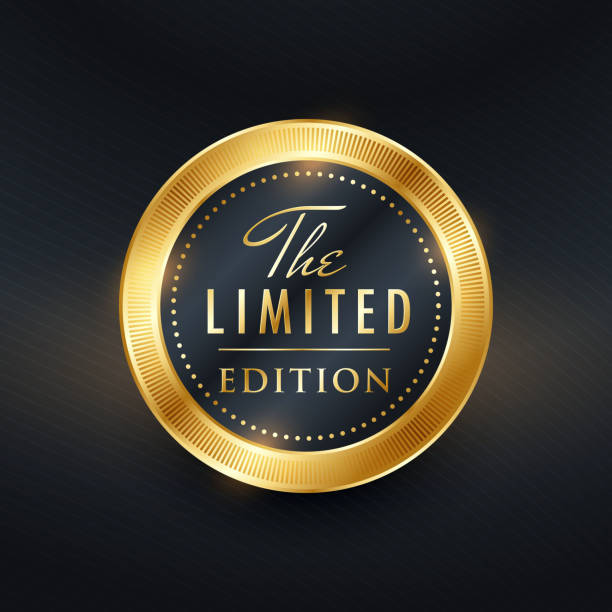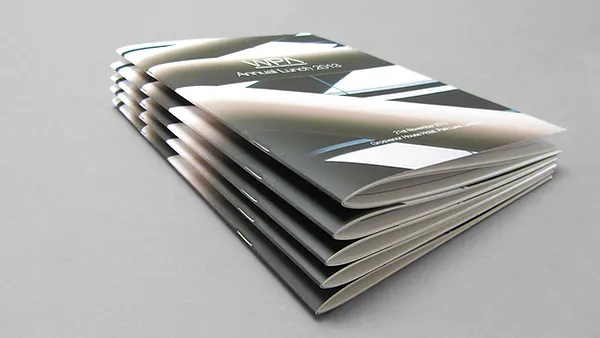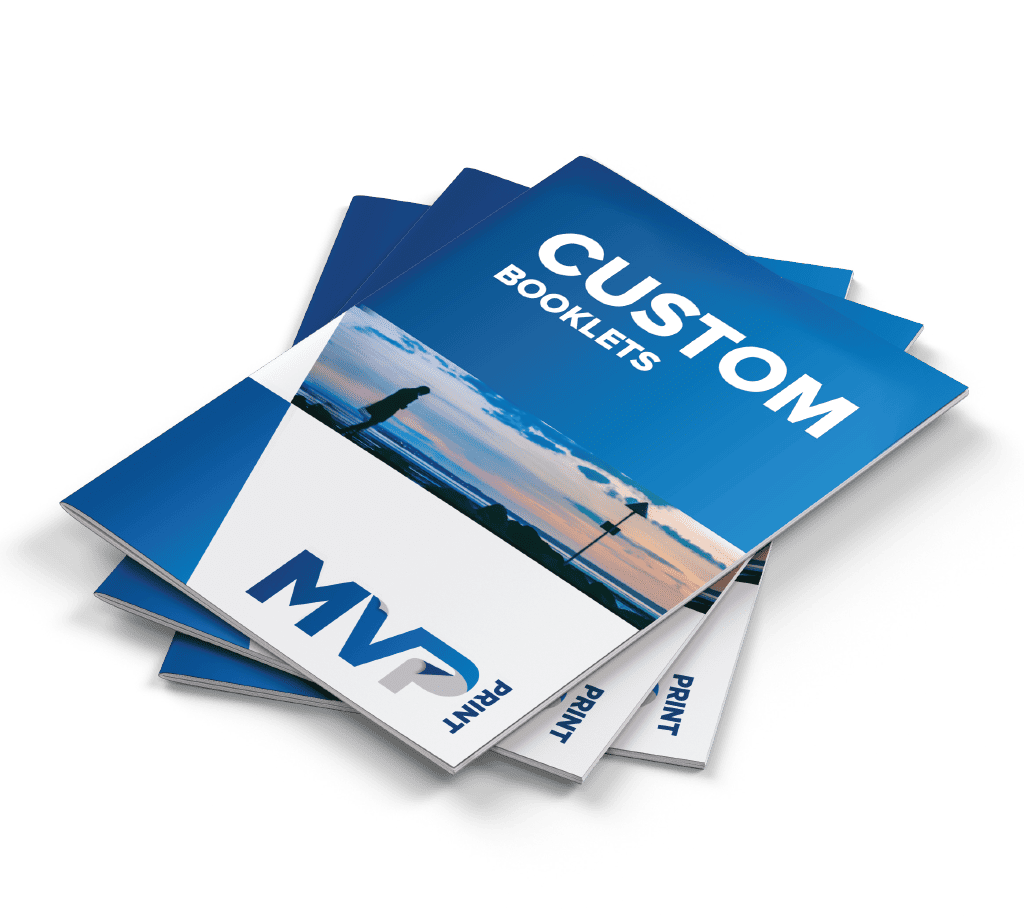
If you’re looking for a versatile and cost-effective option to bring your limited edition prints to life, print saddle stitch books are the ideal solution. Saddle stitching, a popular binding technique, offers a clean and secure binding for booklets, brochures, and more. At MVP Print, a reputable printing company in Australia, we specialize in creating top-quality saddle stitched booklets that perfectly blend aesthetics and functionality.
Understanding the Appeal of Saddle Stitch Booklets
Saddle stitch booklets have gained popularity due to their clean and secure binding, making them an appealing choice for various printing projects. This section will delve into the basics of saddle stitch binding, explore why saddle stitch is perfect for limited edition prints, and compare it with other binding methods.
The Basics of Saddle Stitch Binding
Saddle stitch binding is a technique commonly used for creating booklets, brochures, and multi-page printed materials. It involves folding sheets of paper in half and stapling (with wire staples) them along the folded crease.
This binding method offers several advantages, including:
- Cost-effectiveness
- Ease of use and readability
- The ability to open flat, allowing for seamless reading and reference
By understanding the basics of saddle stitch binding, we can appreciate the unique qualities it brings to limited edition prints.
Why Saddle Stitch is Perfect for Limited Edition Prints

Saddle stitch booklets are an ideal option for limited edition prints for several reasons:
- Cost-effectiveness: Limited edition prints typically require smaller print runs, and saddle stitch binding offers a cost-effective solution compared to other binding methods.
- Openability: Saddle stitch booklets can open flat, making it easier to appreciate the artwork and content without any obstruction. This feature enhances the overall reading experience and allows the prints to be displayed effortlessly.
- Aesthetics: The clean and secure binding of saddle stitch booklets adds a professional touch to limited edition prints, ensuring that they are presented in a visually appealing manner.
Considering these factors, it’s evident why saddle stitch is a popular choice for limited edition prints, offering the perfect blend of aesthetics and functionality.
Comparing Saddle Stitch with Other Binding Methods
While saddle stitch binding has its merits, it’s essential to compare it with other binding methods to determine the best option for your printing project. Let’s take a look at how saddle stitch compares to perfect bound booklets and wire binding:
| Binding Method | Advantages | Disadvantages |
|---|---|---|
| Saddle Stitch | – Cost-effective for smaller print runs – Opens flat for easy use and readability – Clean and secure binding | – Limited amout of printed pages – Not suitable for thick materials |
| Perfect Binding | – Suitable for larger page counts – Professional appearance – Durable and long-lasting | – Higher cost per unit – Does not open flat |
| Wire Binding | – Allows for easy page removal and rearrangement – Can accommodate thicker materials | – Not suitable for large page counts – Pages cannot open flat |
By comparing saddle stitch with other binding methods, you can make an informed decision on the most suitable binding option for your specific needs.
Choosing the Right Size and Shape for Impactful Presentation

When it comes to saddle stitch booklets, selecting the appropriate size and shape is crucial for creating an impactful presentation. The size and shape of your booklet can significantly affect its visual appeal and overall effectiveness in conveying your message. Here are some key considerations to keep in mind:
- Consider your booklet’s purpose: Think about the purpose and intended use of your booklet. Is it a product catalog, an event program, or an instruction manual? Understanding the purpose will help you determine the size and shape that best suits your needs.
- Content considerations: Take into account the type and amount of content you plan to include in your booklet. If you have a lot of text, a larger size may be suitable to ensure readability. On the other hand, if your content is more visual-heavy, a smaller size may enhance the impact of your images.
- Seek expert guidance: MVP Print, a reputable printing company in Australia, can provide expert guidance on choosing the right size and shape for your saddle stitch booklets. Their experienced team can help you make informed decisions to maximize the impact of your printed materials.
By carefully considering the purpose, content, and seeking professional guidance, you can ensure that your saddle stitch booklets are sized and shaped to make a lasting impression on your audience.
| Size | Shape | Best Use |
|---|---|---|
| 8.5″ x 11″ | Portrait | Ideal for product catalogs and instruction manuals with detailed information. |
| 5.5″ x 8.5″ | Portrait | Perfect for event programs and brochures with a balanced mix of text and images. |
| 6″ x 6″ | Square | Great for showcasing artistic portfolios or photography collections. |
Print Saddle Stitch Books: A Blend of Aesthetics and Functionality
Advantages of Saddle Stitched Booklets
Saddle stitch booklets offer several advantages that make them a popular choice for a variety of printing projects. Firstly, they are cost-effective, making them suitable for limited edition prints and smaller print runs. The saddle stitch binding technique allows for quick production and turnaround times, making it an efficient option for tight timelines.
Another key advantage is the ability of saddle stitch booklets to open flat, ensuring easy readability and convenient use. This feature makes them ideal for applications such as event programs, product cataloguess, and instruction manuals. Additionally, saddle stitch booklets have a clean and secure binding that enhances the overall aesthetic appeal of the printed piece.
Practical Applications of Saddle Stitch Booklets
Saddle stitched booklet printing has practical applications across various industries and purposes. They are commonly used for event programs, providing a comprehensive guide for attendees. Whether it’s a conference, trade show, or performance, saddle stitch booklets can effectively display schedules, speaker bios, and other relevant information.
Product catalogs are another popular use case for saddle stitch booklets. They allow businesses to showcase their offerings in a visually appealing and organized manner, making it easier for customers to browse and make purchasing decisions.
Furthermore, saddle stitch booklets are ideal for instruction manuals. Their compact and portable format allows users to easily refer to the instructions while performing tasks or assembling products. This makes them valuable tools for industries such as manufacturing, automotive, and electronics.
Navigating Cover and Paper Stock Options with MVP Print
When choosing cover materials and paper stocks for saddle stitch booklets, MVP Print offers a range of options to suit different needs and preferences. For the cover, you can choose from various materials such as cardstock, coated paper, or a self-cover option where the cover printed material is made from the same paper stock as the interior pages.
In terms of paper stock, options include a variety of weights and finishes. Whether you prefer a lightweight and glossy paper for vibrant and eye-catching prints, or a heavier stock for a more luxurious feel, MVP Print can guide you in selecting the right option to achieve the desired outcome for your saddle stitch booklets.
Prepping Your Content: Page Counts and Design Tips

When it comes to creating saddle stitch booklets, prepping your content is a crucial step that can greatly impact the final product. Determining the appropriate page count is essential to ensure that your booklet is well-designed and structurally sound.
Saddle stitch booklets typically have a page count between 8 and 76 pages, with multiples of four. This is because saddle stitching involves folding the printed sheets in half and stapling them along the folded crease. Keeping the page count in multiples of four allows for even and balanced folding and binding. Sometimes, if your page count is not in multiples of 4, you may need to add some blank pages, or a page with a logo (typically on the inside front or back cover, to make the page count viable.
Now that you have an idea of the suitable page count range, it’s important to consider design tips that can enhance the overall appearance and functionality of your saddle stitch booklet.
One design tip to keep in mind is to avoid placing important content too close to the edges. This is because some content may be lost during the trimming process, which can affect the readability and visual appeal of your booklet. Keeping important elements within a safe margin can help ensure that they remain intact.
Another important consideration is the proper alignment of your content for the fold and binding. This includes aligning text, images, and other elements in a way that takes into account the folding and stapling process. Proper alignment will help maintain a clean and professional look throughout your booklet.
| Prepping Your Content Tips | Benefits |
|---|---|
| Choose an appropriate page count | Ensures structural integrity |
| Avoid placing important content near the edges | Preserves content during trimming |
| Properly align content for fold and binding | Maintains a professional look |
Finishing Touches: Selecting Paper Quality and Cover
When it comes to creating a high-quality saddle stitch booklet, the choice of paper quality and cover plays a crucial role. These finishing touches contribute to the overall look and feel of your booklet, enhancing its visual appeal and durability.
Understanding Paper Weights for Your Booklet
One important consideration when selecting paper for your saddle stitch booklet is the paper weight. Paper weight refers to the thickness and density of the paper, and it affects both the durability and the perceived quality of the booklet. Generally, the larger the paper weight, the sturdier and more substantial the booklet will feel.
There are different paper weight options available, usually measured in grams per square meter (GSM). The most common paper weight options for booklets are:
- 80 GSM – A standard weight option suitable for most booklets
- 100 GSM – A slightly heavier weight option for a more substantial feel
- 120 GSM – A heavier weight option for added durability and a premium look
Choosing the right paper weight depends on the purpose and intended use of your booklet. For limited edition prints, opting for a higher paper weight can elevate the perceived value and create a more luxurious experience for the reader.
Self Cover vs. Hard Cover: Which to Choose?
Another decision to make when selecting the cover for your saddle stitch booklet is whether to go with a self cover or a hard cover. Here’s a breakdown of each option:
| Self Cover | Hard Cover |
|---|---|
| A self cover uses the same paper stock as the interior pages. It offers a cohesive and seamless look, creating a unified aesthetic for your booklet. | A hard cover, as the name suggests, is a separate, thicker cover that provides additional protection and durability. It can be made from cardboard, laminated paper, or other sturdy materials. |
| A self cover is a more cost-effective option, as it uses the same paper throughout the booklet. | A hard cover adds a premium touch to your booklet and enhances its longevity. It provides extra protection against wear and tear. |
When deciding between a self cover and a hard cover, consider the intended use of your booklet and your budget. A self cover is a great choice for booklets that will be handled frequently or for shorter print runs. On the other hand, a hard cover is recommended for booklets that require extra durability or have a higher perceived value.
At MVP Print, we offer a wide range of paper weights and cover options to help you achieve the desired look and functionality for your saddle stitch booklet. Our team is dedicated to ensuring your booklet reflects your vision and exceeds your expectations. Contact us today to discuss your printing needs and discover the possibilities!
Design Essentials for Saddle Stitch Booklets

When it comes to designing saddle stitch booklets, there are a few essential elements that require careful attention. These design considerations play a vital role in creating visually appealing and well-structured booklets. From the layout to font selection and imagery, each element contributes to the overall impact of the final product.
Layout: A well-designed layout is key to a successful saddle stitch booklet. Consider the flow of information and how it will be presented on each page. Use a consistent structure throughout the booklet to maintain a professional and organized appearance.
Font Selection: Choosing the right fonts can significantly enhance the readability and aesthetics of your saddle stitch booklet. Opt for legible fonts that are appropriate for your content and align with your branding. A harmonious combination of fonts can create visual interest and convey your message effectively.
Images: Incorporating high-quality images can bring your saddle stitch booklet to life. Whether it’s product photography, illustrations, or infographics, visually engaging images can capture your audience’s attention and enhance the overall design. Ensure that the images are relevant to your content and appropriately sized for optimal visual impact.
By focusing on these design essentials, you can create saddle stitch booklets that are not only visually appealing but also well-structured and engaging. The careful consideration of layout, font selection, and imagery will contribute to the overall success of your printed booklet.
| Design Essentials | Saddle Stitch Booklets |
|---|---|
| Layout | Ensure a well-designed and consistent structure throughout the booklet. |
| Font Selection | Choose legible and appropriate fonts to enhance readability and aesthetics. |
| Images | Incorporate high-quality and relevant images to bring your booklet to life. |
Ensuring Precise and Accurate Booklet Assembly
The assembly of saddle stitch booklets requires precision and accuracy to ensure a professional finish. From the printing press to binding, each step in the process contributes to the overall quality of the final product.
The Importance of Professional Finishing
Professional finishing is a crucial aspect of saddle stitch booklet assembly. It involves carefully aligning the pages, trimming any excess paper, and ensuring that the staples are properly inserted along the folded crease. Without professional finishing, the booklet may appear uneven and unpolished, detracting from its overall impact.
From the Printing Press to Binding: A Step-by-Step Process
The step-by-step process of assembling saddle stitch booklets involves several key stages:
- Printing: The booklet’s pages are printed using high-quality printing presses to ensure sharp and vibrant images, text clarity, and color accuracy.
- Folding: Each printed sheet is precisely folded in half to create the booklet’s page size.
- Collating: The folded sheets are arranged in the correct order, ensuring that the pages are in sequence.
- Trimming: Excess paper is trimmed from the edges to create clean and uniform booklet pages.
- Stapling: The folded and trimmed pages are then stapled along the folded crease, securely binding them together.
- Final Trimming: The edges of the booklet are trimmed to ensure a neat and professional appearance.
- Quality Check: The assembled booklet undergoes a thorough quality check to ensure that all pages are properly aligned, the staples are secure, and the overall finish meets the highest standards.
The step-by-step process ensures that every saddle stitch booklet is carefully crafted with attention to detail, resulting in a professional and visually appealing finished product.
| Step | Description |
|---|---|
| Printing | The pages of the booklet are printed using high-quality printing presses. |
| Folding | The printed sheets are folded in half to create the booklet’s page size. |
| Collating | The folded sheets are arranged in the correct order. |
| Trimming | Excess paper is trimmed from the edges. |
| Stapling | The folded and trimmed pages are stapled along the folded crease. |
| Final Trimming | The edges of the booklet are trimmed for a clean and professional appearance. |
| Quality Check | The assembled booklet undergoes a thorough quality check. |
Tailoring Saddle Stitch Booklets to Various Uses
Saddle stitch booklets offer a versatile solution for a wide range of uses. Whether you need event programs, product catalogues, instruction manuals, or marketing brochures, saddle stitch booklets can be tailored to meet your specific needs.
Understanding the requirements and objectives of each use case is essential for creating customized saddle stitch booklets. By considering factors such as content, design, and desired functionality, you can ensure that your saddle stitch booklets effectively serve their intended purpose.
For event programs, you may want to include schedules, speaker bios, and other pertinent information. Product catalogs can showcase your offerings with engaging images, detailed descriptions, and ordering information. Instruction manuals may require step-by-step instructions, diagrams, and safety precautions. Marketing brochures can be designed to highlight key features, benefits, and unique selling points of your products or services.
Tailoring saddle stitch booklets to various uses allows you to create materials that resonate with your audience and provide a seamless user experience. Partnering with a trusted printing company like MVP Print ensures that your saddle stitch booklets are professionally produced and meet the highest quality standards.
Customization and Printing Options at MVP Print
MVP Print offers a range of customization options for saddle stitch booklets to ensure your final product meets your unique requirements. From custom sizes to paper type selection, you have the flexibility to create a tailor-made booklet that stands out.
Custom Size and Paper Type Selection
At MVP Print, you have the freedom to choose the ideal size for your saddle stitch booklet. Whether you prefer a traditional size or a custom size, our team can accommodate your specifications. This customization option allows you to create booklets that perfectly fit your content and stand out from the crowd.
Additionally, we provide various paper types to suit your desired aesthetic and functionality. From glossy to matte finishes, we offer a wide selection of premium-quality paper stocks. Our experts can guide you in selecting the best paper type that enhances the overall look and feel of your saddle stitch booklets.
Innovations in Saddle Stitch Booklet Printing

At MVP Print, we stay at the forefront of the printing industry, embracing innovations that enhance the saddle stitch booklet printing process. Our state-of-the-art technology ensures high precision and exceptional print quality for your booklets.
We utilize advanced printing techniques to bring your designs to life with vibrant colors and sharp details. Our cutting-edge equipment enables efficient production, resulting in quick turnaround times without compromising on quality.
With our commitment to innovation, we continuously explore new techniques and technologies to push the boundaries of saddle stitch booklet printing. Partnering with MVP Print means gaining access to the latest advancements in the industry.
Customization options, custom size and paper type selection, and innovations in saddle stitch booklet printing are just a few of the ways MVP Print can help bring your vision to life. Contact us today to discuss your printing needs and unlock the full potential of saddle stitch booklets.
Cost Effectiveness of Saddle Stitch Book Printing
Saddle stitch book printing is an ideal option for those looking for a cost-effective solution, especially for short print runs. The saddle stitch binding technique, which involves folding sheets of paper in half and stapling them along the crease, is not only efficient but also economical.
With MVP Print, you can enjoy competitive pricing and cost-effective solutions for all your saddle stitch book projects. As a reputable printing company in Australia, MVP Print specializes in saddle stitched book production and understands the importance of providing affordable options without compromising on quality.
For thicker booklets (eg over 80 printed pages), check our extensive range of Perfect Bound or Wire Bound Books. Producing booklets and books is one of our passions, and saddle stitched books are one of hottest ticket items !
Maximizing the Impact of Your Limited Edition Prints
When it comes to limited edition prints, maximizing their impact requires a strategic approach to both distribution and marketing. In this section, we will explore various strategies that can help you reach your target audience and create a lasting impression with high-quality printing.
Strategies for Distribution and Marketing
Effective distribution and marketing play a crucial role in ensuring that your limited edition prints reach the right audience. Consider the following strategies:
- Identify niche markets: Research and identify specific niche markets that align with your limited edition prints. This will help you target a more focused audience that is likely to appreciate and value your artwork.
- Collaborate with influencers: Partnering with influencers and artists who have a strong presence in your target market can significantly boost the visibility and reach of your limited edition prints.
- Explore online platforms: Utilize e-commerce platforms, online galleries, and social media channels to showcase and sell your limited edition prints. This allows you to reach a wider audience and engage with potential buyers.
- Organize exhibitions and events: Hosting exhibitions and events dedicated to limited edition prints can generate buzz and attract art enthusiasts who are eager to discover new and unique pieces.
Creating a Lasting Impression with High-Quality Printing
High-quality printing is essential for creating a lasting impression with your limited edition prints. Consider the following factors:
- Choose the right printing technique: Opt for high-quality printing techniques, such as giclée printing, that can reproduce the fine details and vibrant colors of your artwork.
- Select premium paper stocks: Use high-quality paper stocks that not only enhance the visual appeal of your prints but also provide durability and longevity.
- Invest in professional printing services: Collaborate with a reputable printing company, like MVP Print, that specializes in producing limited edition prints. Their expertise and attention to detail can ensure that your prints are of the highest quality.
By implementing effective distribution and marketing strategies and prioritizing high-quality printing, you can maximize the impact of your limited edition prints and captivate your target audience.
| Section | Heading |
|---|---|
| 12 | Maximizing the Impact of Your Limited Edition Prints |
Conclusion
Print saddle stitch books provide a versatile and cost-effective option for limited edition prints. The saddle stitch binding technique allows for secure and flat opening booklets, making them easy to use and read. MVP Print, a reputable printing company in Australia, specializes in saddle stitch booklets and can help bring your limited edition print projects to life.
There are several advantages to using saddle stitch booklets. They are cost-effective, quick to produce, and offer a seamless blend of aesthetics and functionality. Whether you need event programs, product catalogues, or instruction manuals, saddle stitch booklets are a practical choice for various applications.
Choosing the right size and shape is crucial for creating an impactful presentation. Consider the content and purpose of your booklet when making these decisions. MVP Print can provide expert guidance and assist in selecting the perfect size and shape for your saddle stitch booklets.







